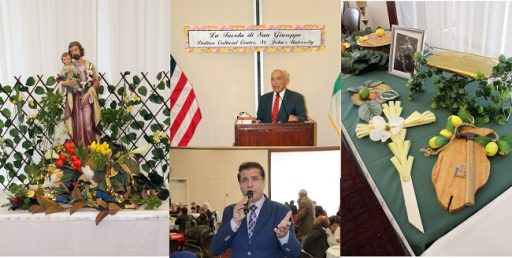By Joseph M. Calisi ©2022 All Rights Reserved
Jamaica, NY, March 20, 2022
For the first time in 2 years, the Italian Cultural Center celebrated the Feast of St Joseph (Festa di San Giuseppe) at the St. John’s University (JSU) Queens campus. The entire event was led and planned by Joseph Sciame (Chair, Italian Cultural Center Advisory Board and Vice-President for SJU Community Relations) and Fiorentina Russo on the 4th floor of the Student Union D’Angelo Center. The 2020 in-person measures were taken due to the effects of the Chinese virus but virtual events were held instead.
The celebration began with a mass in Italian at St. Thomas Moore Church on the SJU campus that was conducted by Monsignor Steven Agugia, who later blessed the altar to St. Joseph and the celebration, which began at 1 pm.
Photo by Joseph M. Calisi ©2022 All Rights Reserved
St. Joseph’s Day has triple significance:
As the adoptive father of Jesus, he taught not only carpentry but life lessons to the young Jesus.
As with many things Italian food was available with a traditional Sicilian Luncheon and Tavola di San Giuseppe (altar dedicated to St. Joseph) and welcomed a special guest entertainer DJ/singer Antonio Guarna.
The meaning of the altar with food has special significance beyond using the colors of the Italian flag.
Photo by Joseph M. Calisi ©2022 All Rights Reserved
In Sicily and Southern Italy, there was a drought with a resulting famine and crops couldn’t grow. The populous decide to pray to St. Joseph for help and the rains came shortly thereafter, allowing the crops to finally grow. In honor of the rain and bounty that resulted, the annual feast has an altar with food that was grown that is blessed with holy water. Among the items on the altar were dogwood branches and foods made with farmed ingredients such as parsley; flour; chickpeas, and; fava beans, blood oranges, bread, and other Sicilian-based products.
Photo by Joseph M. Calisi ©2022 All Rights Reserved
Photo may not be used/published unless invoiced/paid for/by agreement.
An interesting aside is that some of the baked bread mimic St. Joseph’s beard.
The third significance is that St. Joseph’s Day is also celebrated as Father’s Day in Italy.
At the podium, Florentina Russo elaborated on the element of poverty and said, “The table, as always, highlights the underlying theme of poverty where it outreaches to the impoverished neighbors in little towns in Southern Italy struck by famine and drought. Here the ‘tavola’ symbolizes charity to the poor. The tradition was to invite neighbors usually with a symbolic number of three main protagonists formed by neighbors to symbolize the Holy Family.” She went on to add that, “The bread crumbs (present in the “pasta con sarde (sardines) pasta with sardines used in the dinner represent the sawdust from St. Joseph’s craft as a carpenter also highlight the meal’s humble origins, as the poor could not use grated cheese on pasta, but used a breadcrumb topping instead. The carpentry of St. Joseph is also underscored by the presence of a hammer and nails on the table for decoration.”
The food was presented in a buffet style that featured the traditional Sicilian-style pasta of San Giuseppe with Bucatini (a/k/a perciatelli) with a topping of cooked sardines and toasted bread crumbs.

